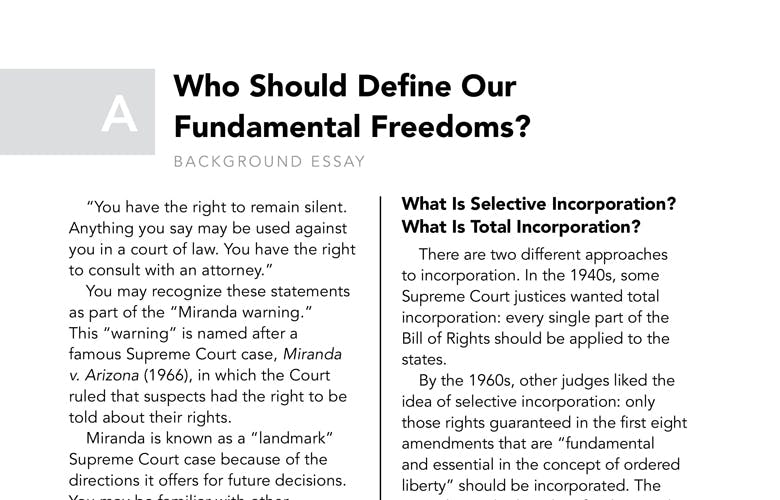Handout A: Who Should Define Our Fundamental Freedoms? (Background Essay)
“You have the right to remain silent. Anything you say may be used against you in a court of law. You have the right to consult with an attorney.”
You may recognize these statements as part of the “Miranda warning.” This “warning” is named after a famous Supreme Court case, Miranda v. Arizona (1966), in which the Court ruled that suspects had the right to be told about their rights.
Miranda is known as a “landmark” Supreme Court case because of the directions it offers for future decisions. You may be familiar with other landmark cases: Gitlow v. New York (1925), Everson v. Board of Education (1947), Mapp v. Ohio (1961), Gideon v. Wainwright (1963). What do all these landmark cases have in common? Each of these decisions incorporated part of the Bill of Rights to apply to the states.
In the Gitlow case, the Supreme Court interpreted the Fourteenth Amendment to mean that the right to free speech must be recognized at the state level as well as the national level. Up to this point, the Bill of Rights had only applied to the federal government. This meant that states could establish religions or refuse a person due process rights if those rights were not protected in their own state constitutions.
What Is Selective Incorporation? What Is Total Incorporation?
There are two different approaches to incorporation. In the 1940s, some Supreme Court justices wanted total incorporation: every single part of the Bill of Rights should be applied to the states.
By the 1960s, other judges liked the idea of selective incorporation: only those rights guaranteed in the first eight amendments that are “fundamental and essential in the concept of ordered liberty” should be incorporated. The Court has to look at the “fundamental fairness” of laws. Are the laws fairly written? Are they fairly applied? Incorporation should only happen when the actions of a state violate a fundamental freedom and “shock the conscience.”
Since the 1920s, parts of the Bill of Rights have been incorporated selectively. Each right has been incorporated as a result of a specific Supreme Court decision. Over time, almost every right has been incorporated, and so the result is almost total incorporation.
Why Does It Matter?
Whether the federal government or state governments can more effectively promote individual liberties is a question that has been debated since the Founding.
When the Founders ratified the Bill of Rights, individuals had very little contact with the federal government. Most people thought of themselves as citizens of their states. Most political decisions happened at the state level. The role of the federal government was generally limited to national defense and foreign relations. Citizens felt protected by their own state’s bill of rights.
Incorporation increased the role of the federal government in citizens’ lives. Many people now expect that the federal government—not the states—will be the main protector of individual rights. The Bill of Rights was originally a list of limits on the federal government. Incorporation means that these limits are enforced on the states by the federal government.
Some legal scholars support incorporation. They see it as the fulfillment of the Declaration of Independence and its promise of “inalienable” rights. To them, it seems only logical that those same rights should also be protected from the state governments.
Incorporation also gives more power to American citizens. They now have a way to challenge most government action in federal court.
Other scholars think that incorporation gives the Supreme Court too much power to define “fundamental fairness.”
Essentially, the federal government has veto power over state law. When the Constitution was written, James Madison wanted this power for the federal government, but other Founders believed it was a bad idea and overruled him.
What Is the Future of Incorporation?
In 2010, the Supreme Court incorporated one more right: the individual right to own handguns. In the landmark decision of McDonald v. Chicago (2010), the Court held that the right of an individual to “keep and bear arms” is a fundamental right. That right is incorporated by the due process clause of the Fourteenth Amendment. Therefore, it applies to the states.
One justice disagreed with this reasoning. Associate Justice Stephen Breyer argued that “the Framers did not write the Second Amendment in order to protect a private right of armed self-defense. There has been, and is, no consensus that the right is, or was, ‘fundamental.’”
If members of the Supreme Court disagree about what is a fundamental right, how can ordinary Americans figure it out? If the Supreme Court is the only institution to define “fundamental fairness,” what options do citizens have if they disagree with those definitions? Incorporation continues to be a controversial subject for all Americans.
Critical Thinking Questions
- What is a “landmark case”?
- Briefly describe the two different approaches to incorporation.
- What actions taken by your state government would “shock” your conscience? What would be the best way to ensure that these actions don’t occur?
- How has incorporation increased the role of the federal government in people’s lives?
- The Bill of Rights was originally a list of limits on the federal government. Incorporation means that these limits are enforced by the federal government.
What conflicts, problems, or tensions could this situation create? - Does the Supreme Court have too much power to define fundamental rights?
- What are five or six fundamental rights shared by all Americans?
